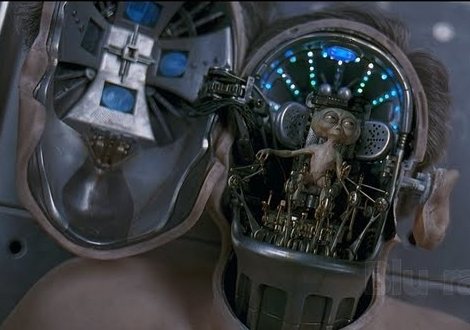Originally published in Psychology Today on March 21st, 2017.
One of the great privileges of working in psychiatry currently is witnessing the amazing progress of so-called ‘biological psychiatry’. Advances in neurosciences and brain imaging are providing us with closer and closer glimpses of the basis of psychopathology. But for some this reductionism can lead psychiatry astray. When a person is reduced to different brain regions and neurotransmitters a single head-dwelling subject of memories, emotions, traumas and setbacks is nowhere to be seen. To whom, then, are we delivering psychotherapy?
If traditional ideas of psychotherapy are to be preserved, there is a temptation to conceptualise the self as separate and irreducible; something that Gilbert Ryle described as a “ghost in the machine”. But the self is just an illusion and, as I noted in a recent paper published in Australasian Psychiatry, acknowledging this more widely within our field could be beneficial.
The self feels like a discrete and pervasive entity; An experiencer separate from the experience; A thinker separate from the thoughts. I feel I am the same self as I was yesterday, last month and last year; that there is some underlying principle that connects these different points in time and unifies ‘me’. Yet this can’t be mapped onto reality, whether via neuroscience, philosophy or experience.

The concept of a self makes no anatomical sense, as neuroscientists have discovered there is no discrete place in the brain where it can be located. Philosophers reasoned this conclusion long ago. As Daniel Dennett would say, there is no “Cartesian Theatre” playing for an ‘I’ – a little homunculus – inside your head, as this would only beg the question: where is the self within that subjects’s head? This thought quickly reveals an infinite regress; one would have to explain the subjectivity of the subject, and so on. Through meditation, the Buddha discovered the selfless nature of our existence from a first-person perspective, as have many since.
The parts that construct the holistic self-illusion are also in constant flux. Various mental aspects such as personality, memories, and patterns of reasoning change in specific ways when the brain is impinged upon by tumours, strokes, drugs, trauma, ageing and even mere experience itself. The self is not an entity that stretches over time, transcending these relentless fluctuations and permanent alterations.
Saying the self is an illusion does not mean our experience of the self does not exist, but rather our common ideas of what it is, how it occurs, and what it means, are mistaken. If a magician performs a trick in which she miraculously picks your card from a completely shuffled deck, she creates the illusion of magic. Notice that saying it is an illusion does not mean the magician did not pick your card, rather it occurred in a way that was different to your perception; there was no magic.
So if the self is an illusion, what is it? It’s part of a simulation (think ‘The Matrix’). Our nervous systems model the world we live in, and a valuable model provides an organism with the most useful information on which to plan and execute behaviours in a quick and efficient manner. In addition to sights and smells, this model also includes the self.
Our Matrix is built from sparse bits of information, which are then modified and supplemented by assumptions and alterations to construct a complete view of the self and surrounding world. Optical illusions provide a useful concrete example of this by isolating one of many model-generating assumptions of the visual system and playing with it. For example, the Kanizsa Square illusion takes advantage of presumptuous edge-detecting neurons, providing the experience of a white square that is objectively absent. One can imagine the self as this square; an illusion created by, and wholly dependent on, surrounding elements. Self-generating components, including memories, beliefs, intentions, and perceptual bias, can be conceptualised as the partial circles of the Kanizsa Square illusion.

The self-illusion possesses a powerful tendency towards coherence; The illusory square wants to remain a square. Indeed, we should remember that the forces of evolution by natural selection have not necessarily favoured continually happy organisms, but coherent beings that are able to survive and reproduce in a hostile environment. Cognitive dissonance ensures our beliefs, intentions and behaviours reliably align (e.g Aesop’s fox and sour grapes tale). Memories – rather than being like reliably taped videos – are stored and retrieved in a way that agrees with our worldview, emotions and pre-existing memories. Filling our sense stores with seamless and comprehensible smells, sounds and sights is a very active task involving the predictions of ‘top-down processing’ (e.g the Kanizsa Square).
If in every moment of our lives we approached experiences as if they were a baby’s first steps, we would never leave the house in the morning. If we treated others as masses of complex parallel neural processes, we would be overwhelmed by the sheer complexity of just talking to someone. We cannot continually question ourselves and our surroundings, and the self provides a useful summary.
But what if the self being propped up is a poor one? Consider someone suffering from depression – we have come to understand that they have a distorted picture of the world, known as Beck’s cognitive triad: I am worthless, the world is unfair, the future is hopeless. Through cognitive dissonance, top down processing, cognitive biases and memory alteration, people will construct a world around them that fits their existing narrative. They will seek out and accept those things that fit their world-view, and when they don’t, they will modify the details so they do.
However, we can take advantage of the fact that the self is an illusion that is constantly changing. By knowing how the self is constructed – whether in the present moment or over time – psychotherapists can tailor therapy to override or highjack the mechanisms that give rise to it. Encouragingly, a lot of this is already been done in therapy – albeit under different banners and driven by widely varied reasoning.

For instance, through behavioural therapy, patients can summon the forces of cognitive dissonance by repeatedly acting in a way that contradicts views of ones self, putting pressure on those views to shift. Mindfulness meditation trains attention on raw, ‘bottom-up’ experience, rather than being lost in ‘top-down’ patterns of problematic expectations and reactions by being able to notice and disengage from them. Importantly, once one begins to change the self-illusion, a positive feedback loop can be achieved by the same self-constructing processes mentioned above. A patient’s perception of reality can be fundamentally altered, and may explain why benefits of psychotherapy tend to persist and accumulate after cessation of treatment.
Viewing the self as an illusion also helps facilitate an important conceptual shift. When the self is mistaken as a single inner being, one is led to assume it is a linear system. A linear system responds to outside influence in a predictable manner – such as two billiard balls deflecting off each other. However the self-illusion reminds us it is nonlinear; a complex system.

Chaos theory – made famous through the so-called “butterfly effect” – has revealed that finer knowledge of a complex system does not necessarily provide superior predictive power for the system’s future behaviour. In other words, selfs are like clouds rather than like clocks. So if the self is the product of a complex system, the inability to predict future mental states and behaviours of patients such as suicide is not simply a pragmatic issue of requiring more data; it is a mathematical principle, and forgetting this may be wasting both therapists’ and patients’ time. In fact, psychologist Philip Tetlock has found that political analysts who suspect politics is more cloudlike are actually more accurate in predicting longer-term futures than forecasters who believed that it is more clocklike.
Another important consequence of this way of thinking is that complex networks such as economies, transport systems and ecosystems are the most robust and flexible when they are endowed with good interconnectivity. Indeed, the expanding field of network science is revealing that psychiatric illnesses such as schizophrenia and depression are likely ‘connectopathies’: diseases mediated by aberrant wiring of the brain. Additionally, the self illusion does not exist in a vacuum, but is embedded in a larger social network. A huge focus for psychotherapy therefore lies in facilitating enhanced interconnectivity – of both the nervous system itself and its relationship to others. (Indeed, brain imaging studies are finding that both psychotherapy and short courses of mindfulness result in important increases in structural and functional connectivity).

Rather than persisting with outdated ideas of a separate and irreducible self, acknowledging what the self actually is will allow us to focus on the mechanisms that give rise to it and fix it when things go wrong. As cardiologists could only make significant headway when they understood what the heart actually was, psychotherapy might make significant strides forward when we understand what the self is. This idea can be incredibly empowering for not only psychotherapists and their patients, but all of us. The self – our identity – is not an act of finding; It’s an act of creation. There is no true me or you, and our malleability is only restricted by the tools we possess to alter it.
Follow Steve on Twitter.
“The self is an illusion” is an oxymoron, because a self is required to experience an illusion. Neuroscience suggests that we exist as mental processes running on the hardware of our neurology. By poking at the hardware with an electrode we can trigger memories of experiences. By analyzing the effects of injuries to specific neural areas we can identify physical areas responsible for specific parts of our mental experience.
In a computer, there is the software running as a process on the hardware. The self is the process that is responsible for what the body decides to do. And, regardless of the parts, the whole person will be held responsible if the fist of the body punches someone else’s nose.
The advances in ‘biological psychiatry is something that astonishes me more and more each day. Great read. Do you post often?
Thanks Natalija. About once a month at the moment.